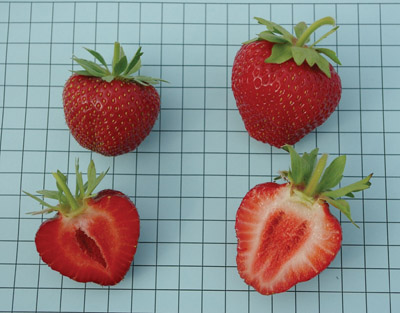
Features
Production
Research
Working to advance Atlantic Canada’s strawberry season
September 16, 2010 By Dan Woolley
In the past 60 years, Agriculture and Agri-Food Canada’s (AAFC)
Kentville research centre has developed some 16 varieties of
strawberries. Of that number, Dr. Andrew Jamieson has bred eight of
them.
In the past 60 years, Agriculture and Agri-Food Canada’s (AAFC) Kentville research centre has developed some 16 varieties of strawberries. Of that number, Dr. Andrew Jamieson has bred eight of them.
 |
|
| Agriculture & Agri-Food Canada plant breeder Dr. Andrew Jamieson’s latest strawberry cultivar, AC Valley Sunset, was introduced in 2009. It is a late season, short-day type. Here it is compared with the variety Bounty (left). Photo courtesy of the CFIA Advertisement
|
His latest strawberry cultivar introduced in 2009, AC Valley Sunset, is a late season, short-day type. It is unlike AC Wendy, an early season, short-day cultivar he brought to market in 2006. Even so, AC Valley Sunset is selling very well, says Dr. Jamieson.
“Short-day types are still worth breeding since they still dominate production and there are improvements yet to be made,” he said.
With the peak Nova Scotia strawberry season running from late June to mid-July, it’s hoped AC Valley Sunset will extend the season to the end of July, he says.
Valley Sunset also produces very large berries, says Dr. Jamieson. “Because of its late season of harvest, some growers have found it a useful bridge with raspberry season to keep the pickers interested.”
About 95 per cent of the Nova Scotia strawberry acreage is short-day plants, which begin forming flower buds in the fall in response to the short-day length. The buds then fall dormant over winter, developing and blooming in the following spring, he says.
Day-neutral strawberries, by contrast, develop flower buds all summer long and, unless it is too hot, tend to be everbearing.
“At Kentville we are doing very little breeding,” said Dr. Jamieson. “The AAFC strawberry breeding program in Quebec is focusing on day-neutrals and there are several new candidate day-neutral selections from this program currently being trialed.”
Day-neutrals are used primarily to grow berries beyond the traditional strawberry and they will bear, he notes, from August until the temperatures get too cold in the fall.
Day-neutrals are more expensive to produce and more technically demanding. They also usually require plastic mulch with a drip irrigation system and a higher planting density. “These are some of the reasons why there are still so few acres of them,” Dr. Jamieson said.
As for his continued research into short-day strawberry cultivar development, Dr. Jamieson has “a half-dozen promising advanced selections that are being tested or planted into trials this spring.
“I am particularly interested in identifying those with improved fruit quality. Although many people like to complain about the quality of imported out-of-season strawberries, the amount sold in Canada is steadily increasing. I think the quality is also increasing. Therefore, we have to continue to advance the quality of local berries to differentiate ourselves from the competition.”
He and his fellow research scientists at the Atlantic Food and Horticulture Research Centre are interested in increasing the level of disease resistance to reduce the production risks of growers, says Dr. Jamieson.
“Currently, we are doing primary resistance breeding for two diseases: red steel rot and angular leaf spot disease. We also do secondary evaluations in the course of field trials for other diseases such as powdery mildew, leaf spot and leaf scorch. We are always looking for plant types with vigorous healthy foliage.”
Print this page